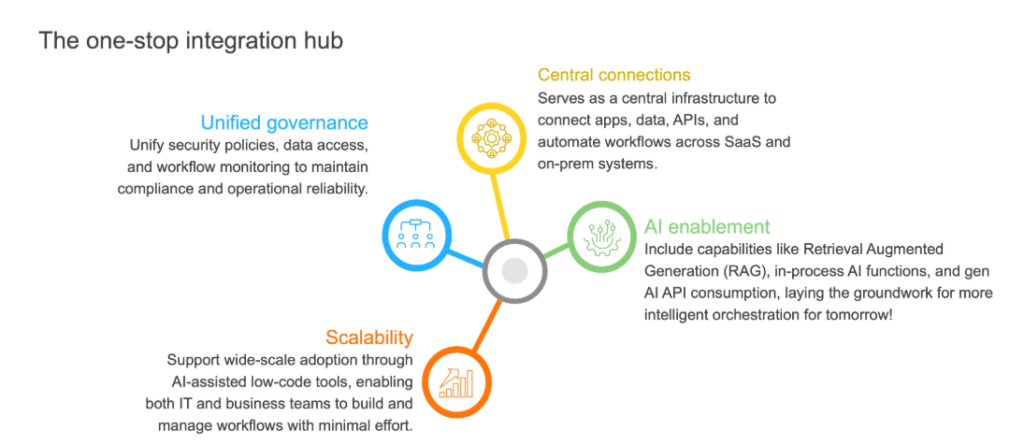Synchronizing Chaos - Transcending Integration into Agentic Orchestration

The Power of a flap
In chaos theory, the Butterfly Effect suggests that the flap of a butterfly’s wings in Brazil could set off a tornado in Texas. This poetic metaphor reveals how even the smallest actions can unleash vast, unpredictable consequences, both positive and negative, shaped by the intent behind the action, the precision of orchestration, and the foresight woven into its design.
In the digital enterprise world, the same logic applies, a small anomaly between two applications can create ripples across environments. However, a well-placed integration between the same two applications can accelerate user experience and drive exponential value.
This blog explores how application integration is evolving into a dynamic orchestration layer for intelligent agents, embodying the Butterfly Effect not merely by linking systems, but by actively sensing, reasoning, and coordinating complex, real-time interactions across the enterprise.
As enterprises move toward hyper-connected, Artificial Intelligence (AI)-augmented ecosystems, these platforms are evolving into agentic orchestration engines, spawning microagents that not only ripple real-time enterprise-wide transformations but also heroically save any villainous ripples from becoming tornadoes.
Reach out to discuss this topic in depth.
The digital chaos: why integration is the bedrock of enterprise evolution
Modern enterprises juggle sprawling tech stacks, legacy estates, data silos, and inconsistent processes. With tech landscapes becoming multi-cloud, Application Programming Interface (API)-first, and data-rich, the demand for automation has never been greater. In such an environment, integration applications play the crucial role of a conduit for the transformational waves of modernization.
Poor integration leads to data silos and miscommunication between applications, leading to costly manual workarounds that cause delays, errors, inflated costs, and events that might magnify into negative ripples.
Integration platforms break down the data silos and enable real-time data flows. With low-code/no-code tools and pre-built connectors, they offer workflow automation, data transformation, observability, and governance, empowering Information Technology (IT) and business teams to scale integrations, reduce errors, accelerate digital transformation, and enhance customer and employee experiences.
While integration used to be static and one-dimensional earlier, it has now started moving towards more complex roles. To be ready to take on such role, the Application integration platforms are becoming more intelligent by the day, merging all capabilities into a singular platform, making them a one-stop shop for all integration needs. Exhibit 1 illustrates how integration platforms must consolidate their diverse capabilities into a unified, one-stop integration hub.

This movement is becoming table-stakes as enterprises grow comfortable with generative AI (gen AI), and aspirations around agentic AI start to gain momentum.
In an applications environment that grows more complex by the minute, integration tools are seen not just as IT plumbing, but as a strategic lever for enterprise agility, intelligence, and transformation. Now, integration platforms are gradually becoming adaptive orchestration layers bridging systems, data, and governance into living, dynamic architecture.
The digital chaos grows: Integrations will evolve into agentic orchestrators
The digital chaos is not going to settle anytime soon. With enterprises now aiming at bringing agentic AI into their digital landscape, where autonomous agents make decisions, take actions, and interact with one another, the potential for both innovation and disruption grows exponentially.
Any small misalignment or unintended action from a single AI agent can cascade into enterprise-wide instability, the tornado! The complexity of managing dozens or hundreds of these agents, each with evolving logic, access to sensitive systems, and the power to act, introduces new risks such as miscommunication between agents, hallucinated instructions, security vulnerabilities, and goal misalignment. This is where the role of an AI orchestrator becomes indispensable.
Serving as the enterprise’s nervous system, integration platforms will evolve to serve as the central orchestrator of AI agents. It will coordinate, govern, interpret context, and ensure alignment with enterprise goals. It will sense micro-flaps, i.e., behavioral anomalies, intent and context drifts, and agent conflicts, and correct the course before they grow into tornadoes.
In the era of agentic AI, orchestration will not be an optional add-on; it will be the strategic stabilizer. Integration applications will evolve into these orchestrators and ensure that integration truly becomes a conduit for intended, value-driven ripples, not unexpected storms.
The rise of autonomous orchestration
The future of integration lies in platforms that think, predict, and act. Integration platforms are evolving into autonomous orchestrators. Exhibit 2 tells how the role of an integration platform will change as an Orchestrator of agents

This cognitive orchestration layer will empower systems to adapt like living organisms, detecting changes, responding intelligently, and self-optimizing.
Designing the right flap
In a world increasingly governed by autonomous agents and intelligent systems, the difference between disruption and transformation lies in how enterprises design and orchestrate the flaps.
Integration platforms are no longer just the glue that holds systems together, they are becoming the sentient conductors of enterprise intelligence. As agentic AI scales, so does the magnitude of every micro-action. A single trigger, left unchecked, can spiral into chaos, or, when orchestrated with intent, become the spark for exponential value.
The enterprises that embrace integration as a strategic, cognitive layer will not only tame the tornadoes but shape the winds of the future. It’s not about the size or complexity of the system, but the foresight in how enterprises design the ripple. In the next wave of enterprise evolution, integration isn’t just a bridge, it’s the engine of transformation.
If you found this blog interesting, check out our Agentic AI: True Autonomy Or Task-based Hyperautomation? | Blog – Everest Group, which delves deeper into another topic regarding Agentic AI.
If you have any questions or want to discuss the evolution of Agentic AI in more depth, please contact Lalith Kumar ([email protected]), Madhurima Chopra ([email protected]) and Piyushi Bhatnagar ([email protected]).